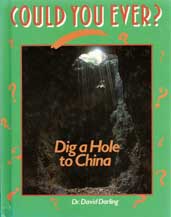COULD YOU EVER DIG A HOLE TO CHINA?: Hands On
Make you own hole in the ground and keep a careful record of what you find
First, make sure you have permission before you begin digging. Choose your site carefully. An empty vegetable plot is ideal.
You will need:
Beneath the ground you are standing on is a history of the people who have lived here, and a history of the Earth itself. The deeper you go, the older the objects you are likely to find. But if the ground has been repeatedly dug up, remains from different periods may have become mixed in the same layer.
Dig slowly and carefully, collecting any interesting stones, soil specimens, bones and human-made objects. Place these in containers labeled with the depth below the surface at which they were buried. Also, make notes of any living things you find, such as plant roots, seeds, worms, larvae, and insects. Use a hand lens or a microscope to examine soil at various depths. What is the deepest that you can identify any life form? Keep a record of your progress and try to decide where the topsoil ends and the subsoil begins.
If your hole gets deeper than about your waist, make sure an adult is watching in case the walls collapse. When you are finished, fill in the hole and leave the area as you found it.
If possible, show your discoveries to a teacher or a museum worker in order to learn more about them. Your local museum or historical society might be especially interested in anything very old or unusual that you find.

